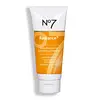What's inside
What's inside
 Key Ingredients
Key Ingredients

 Benefits
Benefits

 Concerns
Concerns

 Ingredients Side-by-side
Ingredients Side-by-side

Prunus Amygdalus Dulcis Oil
Skin ConditioningOrbignya Oleifera Seed Oil
EmollientPEG-20 Glyceryl Triisostearate
EmollientHelianthus Annuus Seed Wax
Skin ConditioningAvena Sativa Kernel Oil
Skin ConditioningPrunus Amygdalus Dulcis Oil, Orbignya Oleifera Seed Oil, PEG-20 Glyceryl Triisostearate, Helianthus Annuus Seed Wax, Avena Sativa Kernel Oil, Phenoxyethanol, Propylene Glycol, Eucalyptus Globulus Leaf Oil, Tocopherol, Panthenol, Limonene, Citric Acid, Bisabolol, Chamomilla Recutita Flower Extract, Water
Water
Skin ConditioningGlycerin
HumectantCocamidopropyl Betaine
CleansingSodium Laureth Sulfate
CleansingDecyl Glucoside
CleansingGlyceryl Oleate
EmollientCoco-Glucoside
CleansingPrunus Armeniaca Seed Powder
AbrasiveAcrylates/C10-30 Alkyl Acrylate Crosspolymer
Emulsion StabilisingPhenoxyethanol
PreservativeSodium Benzoate
MaskingSodium Chloride
MaskingPEG-40 Hydrogenated Castor Oil
EmulsifyingLimonene
PerfumingCitric Acid
Buffering3-O-Ethyl Ascorbic Acid
Skin ConditioningAnthemis Nobilis Flower Water
MaskingDipropylene Glycol
HumectantLinalool
PerfumingSodium Hydroxide
BufferingParfum
MaskingDisodium EDTA
Cocamidopropyl Dimethylamine
EmulsifyingBenzotriazolyl Dodecyl P-Cresol
UV AbsorberSodium Sulfate
Vaccinium Myrtillus Fruit Extract
Skin ConditioningSaccharum Officinarum Extract
MoisturisingPropylene Glycol
HumectantAlcohol Denat.
AntimicrobialCitrus Limon Fruit Extract
MaskingCitrus Aurantium Dulcis Fruit Extract
MaskingAlcohol
Antimicrobial1,2-Hexanediol
Skin ConditioningTris(Tetramethylhydroxypiperidinol)Citrate
StabilisingAcer Saccharum Extract
Skin ConditioningBiosaccharide Gum-4
Skin ConditioningTocopherol
AntioxidantBenzyl Alcohol
PerfumingDenatonium Benzoate
MaskingHydrogenated Palm Glycerides Citrate
EmollientDehydroacetic Acid
PreservativeCI 14700
Cosmetic ColorantCI 15985
Cosmetic ColorantWater, Glycerin, Cocamidopropyl Betaine, Sodium Laureth Sulfate, Decyl Glucoside, Glyceryl Oleate, Coco-Glucoside, Prunus Armeniaca Seed Powder, Acrylates/C10-30 Alkyl Acrylate Crosspolymer, Phenoxyethanol, Sodium Benzoate, Sodium Chloride, PEG-40 Hydrogenated Castor Oil, Limonene, Citric Acid, 3-O-Ethyl Ascorbic Acid, Anthemis Nobilis Flower Water, Dipropylene Glycol, Linalool, Sodium Hydroxide, Parfum, Disodium EDTA, Cocamidopropyl Dimethylamine, Benzotriazolyl Dodecyl P-Cresol, Sodium Sulfate, Vaccinium Myrtillus Fruit Extract, Saccharum Officinarum Extract, Propylene Glycol, Alcohol Denat., Citrus Limon Fruit Extract, Citrus Aurantium Dulcis Fruit Extract, Alcohol, 1,2-Hexanediol, Tris(Tetramethylhydroxypiperidinol)Citrate, Acer Saccharum Extract, Biosaccharide Gum-4, Tocopherol, Benzyl Alcohol, Denatonium Benzoate, Hydrogenated Palm Glycerides Citrate, Dehydroacetic Acid, CI 14700, CI 15985
Ingredients Explained
These ingredients are found in both products.
Ingredients higher up in an ingredient list are typically present in a larger amount.
Citric Acid is an alpha hydroxy acid (AHA) naturally found in citrus fruits like oranges, lemons, and limes.
Like other AHAs, citric acid can exfoliate skin by breaking down the bonds that hold dead skin cells together. This helps reveal smoother and brighter skin underneath.
However, this exfoliating effect only happens at high concentrations (20%) which can be hard to find in cosmetic products.
Due to this, citric acid is usually included in small amounts as a pH adjuster. This helps keep products slightly more acidic and compatible with skin's natural pH.
In skincare formulas, citric acid can:
While it can provide some skin benefits, research shows lactic acid and glycolic acid are generally more effective and less irritating exfoliants.
Most citric acid used in skincare today is made by fermenting sugars (usually from molasses). This synthetic version is identical to the natural citrus form but easier to stabilize and use in formulations.
Read more about some other popular AHA's here:
Learn more about Citric AcidLimonene is a fragrance that adds scent and taste to a formulation.
It's found in the peel oil of citrus fruits and other plants such as lavender and eucalyptus. The scent of limonene is generally described as "sweet citrus".
Limonene acts as an antioxidant, meaning it helps neutralize free radicals.
When exposed to air, oxidized limonene may sensitize the skin. Because of this, limonene is often avoided by people with sensitive skin.
The term 'fragrance' is not regulated in many countries. In many cases, it is up to the brand to define this term. For instance, many brands choose to label themselves as "fragrance-free" because they are not using synthetic fragrances. However, their products may still contain ingredients such as essential oils that are considered a fragrance.
Learn more about LimonenePhenoxyethanol is a preservative that has germicide, antimicrobial, and aromatic properties. Studies show that phenoxyethanol can prevent microbial growth. By itself, it has a scent that is similar to that of a rose.
It's often used in formulations along with Caprylyl Glycol to preserve the shelf life of products.
Propylene Glycol is an odorless, colorless liquid. As a humectant, it helps skin retain moisture. It also aids in delivering active ingredients.
Another role of this ingredient is preventing a product from melting or freezing. Propylene glycol also adds antimicrobrial properties to a product, elongating product lifespan.
This ingredient is considered an organic alcohol and commonly added into both cosmetics and foods.
Those with sensitive skin or conditions may develop a rash when using this ingredient.
Learn more about Propylene GlycolTocopherol (also known as Vitamin E) is a common antioxidant used to help protect the skin from free-radicals and strengthen the skin barrier. It's also fat soluble - this means our skin is great at absorbing it.
Vitamin E also helps keep your natural skin lipids healthy. Your lipid skin barrier naturally consists of lipids, ceramides, and fatty acids. Vitamin E offers extra protection for your skin’s lipid barrier, keeping your skin healthy and nourished.
Another benefit is a bit of UV protection. Vitamin E helps reduce the damage caused by UVB rays. (It should not replace your sunscreen). Combining it with Vitamin C can decrease sunburned cells and hyperpigmentation after UV exposure.
You might have noticed Vitamin E + C often paired together. This is because it is great at stabilizing Vitamin C. Using the two together helps increase the effectiveness of both ingredients.
There are often claims that Vitamin E can reduce/prevent scarring, but these claims haven't been confirmed by scientific research.
Learn more about TocopherolWater. It's the most common cosmetic ingredient of all. You'll usually see it at the top of ingredient lists, meaning that it makes up the largest part of the product.
So why is it so popular? Water most often acts as a solvent - this means that it helps dissolve other ingredients into the formulation.
You'll also recognize water as that liquid we all need to stay alive. If you see this, drink a glass of water. Stay hydrated!
Learn more about Water